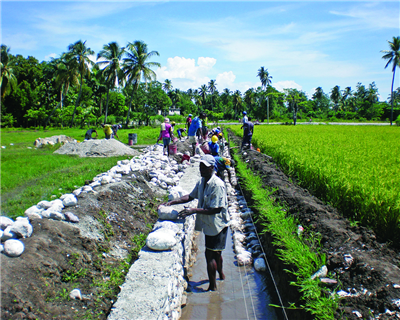Syfaah system to be rolled out in LatAm and Africa
Haiti has found itself at the forefront of agricultural microfinance with an initiative that is shaking up misconceptions about the bankability of smallholder famers and will soon also be launched in Latin America (LatAm) and Africa.

Haiti has found itself at the forefront of agricultural microfinance with an initiative that is shaking up misconceptions about the bankability of smallholder famers and will soon also be launched in Latin America (LatAm) and Africa.
The System of Agriculture Financing and Insurance in Haiti (Syfaah) is a three-pronged initiative that helps smallholders improve their yields and manage their risks through a combination of small loans, insurance products and technical assistance, all of which are tailored to meet farmers’ needs.
By the end of March this year, it had provided 490 million gourdes of credit to more than 6,300 producers across Western Haiti and its Artibonite region, smashing its own target to extend 150 million gourdes of loans to 3,000 producers.
Loans extended under the system were subject to a 30-day delinquency rate of just 7%, compared with a typical rate of at least 10% for other sectors in Haiti and of 14% for agricultural loans offered by credit unions outside Syfaah.
This data proves that agriculture can actually represent a lower-than-average risk to lenders, as long as credit is pack- aged properly with the right support, according to Sylvain Dufour, credit counsellor at Développement International Des- jardins (DID).
It shows that “producers repay better than all other customers,” he says. “I think this system is able to work everywhere.”
Sponsored by Canada, where a similar system helped transform Quebec’s agricultural sector fifty years ago, Syfaah brings together three institutions to offer the three components that Dufour says are key to its success.
The Inter-American Institute for Cooperation on Agriculture (IICA) is responsible for helping smallholders improve their farming methods, offering agricultural experts who advise smallholders and work alongside them at their farms.
DID is responsible for helping farmers access small loans. Since late 2012, it has worked with the local branch of Sogesol bank, credit union Federation des Caisses le Levier and microfinance institution ACME to develop five credit products that stretch across the value chain to finance everything from inputs to storage and processing.
Credit officers have a background in agro-economics, ensuring they understand the needs of farmers and manage financial products that are tailored around the agricultural calendar.
Financière Agricole du Québec Développement International (FADQDI) is responsible for developing and offering two layers of insurance products. The Fonds d’Assurance Prêt en Haïti (FAPAH) provides a partial guarantee to financial institutions lending to farmers under the scheme, and is also piloting an index- based crop insurance programme to cover farmers.
The interplay of these three associations is crucial to Syfaah’s success in Haiti, says Dufour.
Having agricultural experts working with farmers encourages them to follow best practice, meaning that their yields improve and that lenders are more likely to be repaid.
“Employing agro-economists as credit officers means that lenders don’t make the same mistakes as in the past – insisting, for example, that a farmer make monthly repayments rather than repayments that are timed to coincide with the sale of his produce. They understand the producers,” says Dufour. “They are able to adapt the product for what they need.”
Insurance meanwhile provides protection for farmers against the uncertainties of weather, which in turn reduces repayment risks for lenders. The second layer of protection for lenders also gives them the comfort to lend to a sector they were not comfortable with in the past.
Syfaah is now moving on to its second phase, which runs until 2018. It aims to extend the system nationwide, expand its workforce of technical and credit officers, and promote some credit officers to senior positions with higher loan disbursement targets.
It will also create an institution – ideally comprising both government and private-sector partners – that will implement the system once Canada’s sponsorship ends.





